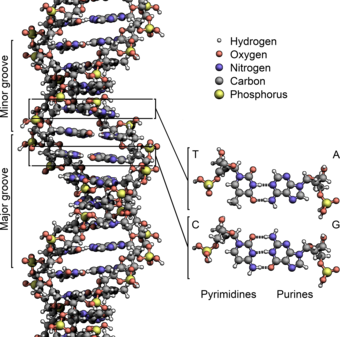 The structur o the DNA
dooble helix
. The
atoms
in the structur are colour-codit bi
element
an the detailed structures o twa base pairs are shawn in the bottom richt.
The structur o the DNA
dooble helix
. The
atoms
in the structur are colour-codit bi
element
an the detailed structures o twa base pairs are shawn in the bottom richt.
 The structur o pairt o a DNA
dooble helix
The structur o pairt o a DNA
dooble helix
Deoxyribonucleic acid
(
DNA
) is a
molecule
that cairies the
genetic
instructions uised in the growthe, development, functionin an
reproduction
o aw kent livin
organisms
an mony
viruses
. DNA an
RNA
are
nucleic acids
; alongside
proteins
,
lipids
an complex carbohydrates (
polysaccharides
), thay are ane o the fower major types o
macromolecules
that are essential for aw kent forms o
life
. Maist DNA molecules conseest o twa
biopolymer
strands coiled aroond ilk ither tae form a
dooble helix
.
The twa DNA strands are termed
polynucleotides
syne thay are componed o simpler
monomer
units cried
nucleotides
.
[1]
[2]
Ilk nucleotide is componed o ane o fower
nitrogen-conteenin
nucleobases
?
cytosine
(C),
guanine
(G),
adenine
(A), or
thymine
(T) ? a
succar
cried
deoxyribose
, an a
phosphate group
. The nucleotides are joined tae ane anither in a cheen bi
covalent bonds
atween the succar o ane nucleotide an the phosphate o the next, resultin in an alternatin
succar-phosphate backbane
. The nitrogenous bases o the twa separate polynucleotide strands are boond thegither, accordin tae
base pairin
rules (A wi T, an C wi G), wi
hydrogen bonds
tae mak dooble-strandit DNA. The tot amount o relatit DNA
base pairs
on Yird is estimatit at 5.0 x 10
37
an wechts 50 billion
tonnes
.
[3]
In comparison the tot
mass
o the
biosphere
haes been estimatit tae be as much as 4
trillion tons
o
carbon
(TtC).
[4]
DNA stores biological
information
. The DNA backbone is resistant tae cleavage, an baith strands o the dooble-strandit structur store the same biological information. This information is replicated as an when the twa strands separate. A lairge pairt o DNA (mair nor 98% for humans) is
non-codin
, meanin that thir sections dae nae serve as patterns for protein sequences.
The twa strands o DNA run in opposite directions tae ilk ither an are thus
antiparallel
. Attached tae each succar is ane o fower types o nucleobases (informally,
bases
). It is the
sequence
o thir fower nucleobases alang the backbone that encodes biological information.
RNA
strands are creatit uisin DNA strands as a template in a process cried
transcription
. Unner the
genetic code
, thir
RNA
strands are translated tae specify the sequence o
amino acids
within proteins in a process cried
translation
.
Within eukaryotic cells DNA is organised intae lang structures cried
chromosomes
. In
cell diveesion
thir chromosomes are duplicated in the process o
DNA replication
, providin each cell its ain complete set o chromosomes.
Eukaryotic organisms
(
ainimals
,
plants
,
fungi
, an
protists
) store maist o thair DNA inside the
cell nucleus
an some o thair DNA in
organelles
, sic as
mitochondria
or
chloroplasts
.
[5]
In contrast
prokaryotes
(
bacteria
an
archaea
) store thair DNA anly in the
cytoplasm
. Within the eukaryotic chromosomes,
chromatin
proteins sic as
histones
compact an organise DNA. Thir compact structures guide the interactions atween DNA an ither proteins, helpin control which pairts o the DNA are transcribed.
DNA wis first isolated bi
Friedrich Miescher
in 1869. Its molecular structur wis identified bi
James Watson
an
Francis Crick
in 1953, whase model-biggin efforts war guidit bi
X-ray diffraction
data acquired bi
Raymond Gosling
, wha wis a post-graduate student o
Rosalind Franklin
. DNA is uised bi researchers as a molecular tuil tae explore physical laws an theories, sic as the
ergodic theorem
an the theory o
elasticity
. The unique material properties o DNA hae made it an attractive molecule for material scientists an engineers interested in micro- an nano-fabrication. Amang notable advances in this field are
DNA origami
an DNA-based hybrid materials.
[6]